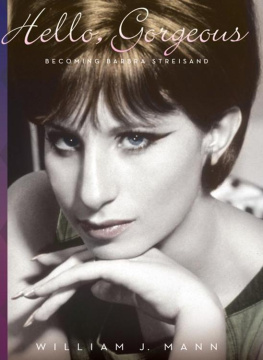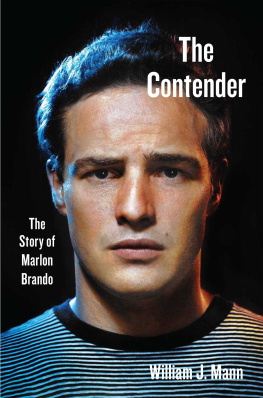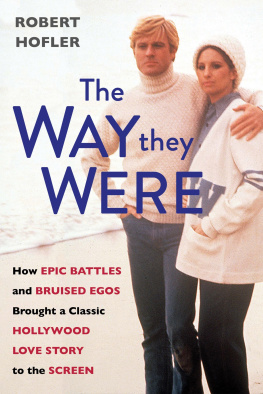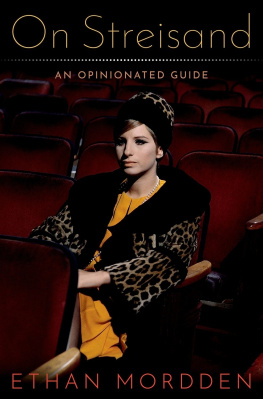
Table of Contents
Copyright 2012 by William J. Mann
All rights reserved
For information about permission to reproduce selections from this book, write to Permissions, Houghton Mifflin Harcourt Publishing Company, 215 Park Avenue South, New York, New York 10003.
www.hmhbooks.com
The Library of Congress has cataloged the print edition as follows:
Mann, William J.
Hello, gorgeous: becoming Barbra Streisand / William J. Mann.
p. cm.
ISBN 978-0-547-36892-4 (hardback)
1. Streisand, Barbra. 2. SingersUnited StatesBiography. I. Title.
ML 420. S 915 M 36 2012
782.42164'092dc23
[B] 2012016364
eISBN 978-0-547-90586-0
v1.1012
For H.B.K.L.
Why Streisand Now
Just five years after arriving in Manhattan as a seventeen-year-old kid without money or connections, Barbra Streisand was the top-selling female recording artist in America and the star of one of Broadways biggest hits. Twenty-two years old, her face graced the covers of Time and Life. That was only the beginning of a career that has marched its band and beat its drum now for half a century, but everything Streisand has accomplished in that time can be traced right back to this first half decade of her professional life.
The young Barbra was like nothing the world of entertainment had ever seen. So fresh, so fearless, so unself-consciousso bursting with desirethat today, even the lady herself seems to cower when confronted with the memory of that young upstart. If Streisand has ever been afraid of anything, I suspect that its been the burden of living up to that sexy, vulnerable, sensational younger self who gate-crashed her way to fame during the turbulent 1960s, defying old definitions of talent, beauty, and success by harnessing an extraordinary confluence of talent, hard work, and shrewd salesmanship. In these all-important formative years, Streisand first learned how to dazzle, how to connect, and how to get what she wanted.
It was also during these years that she learnedin that less comfortable and far less controllable world offstagehow to love, be loved, and lose love. These were the years that the budding Brooklyn teenager born Barbara Streisand would become both a personality and a person, a time when she got her first inkling of how much the artistic affirmation she cravedand the fame that came with itwould cost.
This book charts Barbras climb from her earliest days in Manhattan to her first major triumph, the Broadway musical Funny Girl. After that, her chronicle becomes a very different kind of story: a Cinderella tale after shes secured prince and palace. (Or at least the palace; princes, for Barbra, werent so easy to come by.) My goal has been to understand this early, groundbreaking Streisand, the artist and the woman who, out of need and lack of nurture, transformed herself into a superstar the world loved or loathed, an ambivalence that seemed to mirror the feelings in her own head and heart. Ive attempted to zoom in as closely as possible on this complicated young womannot the constructed myth or iconin order to document how this unlikely kid from Brooklyn turned herself, in just five years time, into the biggest star on the planet.
Much of it, of course, was due to her astonishing talent, and to a voice that pianist Glenn Gould called one of the natural wonders of the age. Streisand came out of a time when talent still mattered, when the pursuit of greatness, not infamy, was rewardeda world very different from ours, where Snooki and the Kardashians and drunken real housewives grab the lions share of media attention. Still, for all her gifts, Streisand wasnt above merchandizing her fame, and during these first five years, she learned to do so expertly. She would cultivate an eccentric personality to go along with the mellifluous voice, knowing it would be the combination of the two that would keep audiences and interviewers coming back for more.
Yet Streisands vaunted ambition remains very different from the lust for notoriety that drives so many of todays celebrities. Barbras determination to reach the big time was never simply an engine to accumulate fans or headlines or even dollars. From the start, she made it clear that she did not wish to be a star having to sign autographs or being recognized and all that. Instead, there were much more human reasons. Barbra wanted to make it big so she could demonstrate she had talent and appeal to a father who had never known her, a mother who hadnt seemed to care, and a world that had thought she was too different to succeed. No surprise, then, that being acknowledged as good would never be enough; Barbra had to be great. And as for paying her dues, she showed little patience: It was right to the top, she declared early on, or nowhere at all.
Of course, Streisands rise has been told before. To say something new and valuable, to put her career into fresh perspective, I have tried to re-create the vanished world of her beginnings. Given my subjects refusal to speak with biographers, I knew I would need to uncover new, authoritative source materials on my own. Happily, I discovered that there were, in fact, several never-before-used collections that provided exactly the kind of detailed inside information I neededmaterial that, as I discovered, did not always jibe with the established canon of Streisands early years.
I cant say that I was surprised by thisthe written historical record often serves as an important corrective to the faulty human memorybut I was nonetheless struck by how many oft-told tales and assumptions about Streisands career turned out to be false. The personal papers of Jerome Robbins, for example, revealed that, contrary to what has always been written, Ray Stark wasnt opposed to Barbras casting in Funny Girl; rather, he was her most ardent champion right from the start. Claims made by Garson Kanin that hed had to persuade Stark to hire Streisand were latter-day self-embellishments (something Kanin was very good at). The Robbins papers clearly show that Barbra was on the project months before Kanin came on board. Likewise, the papers of Bob Fosse finally flesh out that directors rather shadowy involvement with the show. Streisand buffs might want to read my notes thoroughly, as I present evidence that debunks many of the famous myths about her career, such as the story of her being fired from a nightclub in Winnipeg.
Also documented here for the first time is the prodigious amount of backstage maneuvering and public-relations chicanery that propelled Streisand forward. Her ticket to the top was indisputably her voice, but her great good fortune was to choose a crackerjack team of managers, agents, and publicists who made sure that her voice got heard. This able corps of lieutenants, operating largely unseen and unsung, was led, almost from the start, by Marty Erlichman, second only to the lady herself in engineering her brilliant career. Erlichman understood that, contrary to conventional wisdom, Streisands very differenceher unusual looks, her Jewishness, her offbeat mannercould assist her rise, not hinder it. He was able to argue that she was so uniquely talented that her huge fame was simply fated; all they had needed to do to make Barbra a star was wait for her talent to speak for itself. As such, her celebrity wasnt artificially created, Erlichman insisted, but something that simply had to happen. Such a platitude, of course, obscures all the press releases, publicity gimmicks, and backstage deals that Erlichman and his efficient band of foot soldiers waged on their clients behalf, especially during these crucial first five years.
Next page











